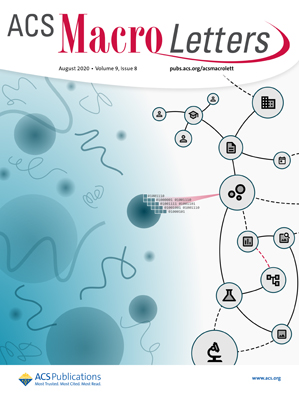Mass-Produced Chemically Recyclable Aromatic Polymers with Exceptional Strength and Stability
IF 5.1
Q1 POLYMER SCIENCE
引用次数: 0
Abstract
Developing chemically recyclable polymers that offer ultrahigh mechanical strength, exceptional chemical stability, mild recycling conditions, and scalability for mass production remains a significant challenge. This study presents a novel class of chemically recyclable plastics, synthesized at kilogram scale in the laboratory, by reversibly cross-linking aromatic polyamide macromonomers with boroxines, imine bonds, and hydrogen bonds. These plastics, denoted as PA-B3O3, exhibit an impressive tensile strength of 142.1 MPa, a Young’s modulus of 2.39 GPa, a glass transition temperature of ∼211.6 °C, and outstanding chemical resistance to acidic/basic aqueous solutions and organic solvents. PA-B3O3 plastics can be depolymerized in a mixed solvent of N,N-dimethylacetamide and aqueous HCl solution, allowing for efficient recovery of the original amino-terminated polyamide (PA-NH2) via precipitation in selective solvents, even when mixed with polymer waste streams. This study represents a significant advancement toward the practical application of mechanically robust, chemically resistant, and recyclable polymers.

大规模生产化学可回收芳香族聚合物具有卓越的强度和稳定性
开发具有超高机械强度、优异的化学稳定性、温和的回收条件和大规模生产可扩展性的化学可回收聚合物仍然是一个重大挑战。本研究提出了一种新型的化学可回收塑料,在实验室中以公斤级合成,通过可逆交联芳香族聚酰胺大单体与硼氧化合物、亚胺键和氢键。这些塑料,表示为PA-B3O3,表现出令人印象深刻的抗拉强度为142.1 MPa,杨氏模量为2.39 GPa,玻璃化转变温度为~ 211.6°C,以及对酸性/碱性水溶液和有机溶剂的优异耐化学性。PA-B3O3塑料可以在N,N-二甲基乙酰胺和水溶液的混合溶剂中解聚,即使与聚合物废物流混合,也可以通过选择性溶剂的沉淀有效地回收原始氨基端聚酰胺(PA-NH2)。这项研究代表了机械坚固、耐化学腐蚀和可回收聚合物实际应用的重大进展。
本文章由计算机程序翻译,如有差异,请以英文原文为准。
求助全文
约1分钟内获得全文
求助全文
来源期刊
CiteScore
10.40
自引率
3.40%
发文量
209
审稿时长
1 months
期刊介绍:
ACS Macro Letters publishes research in all areas of contemporary soft matter science in which macromolecules play a key role, including nanotechnology, self-assembly, supramolecular chemistry, biomaterials, energy generation and storage, and renewable/sustainable materials. Submissions to ACS Macro Letters should justify clearly the rapid disclosure of the key elements of the study. The scope of the journal includes high-impact research of broad interest in all areas of polymer science and engineering, including cross-disciplinary research that interfaces with polymer science.
With the launch of ACS Macro Letters, all Communications that were formerly published in Macromolecules and Biomacromolecules will be published as Letters in ACS Macro Letters.

 求助内容:
求助内容: 应助结果提醒方式:
应助结果提醒方式:


